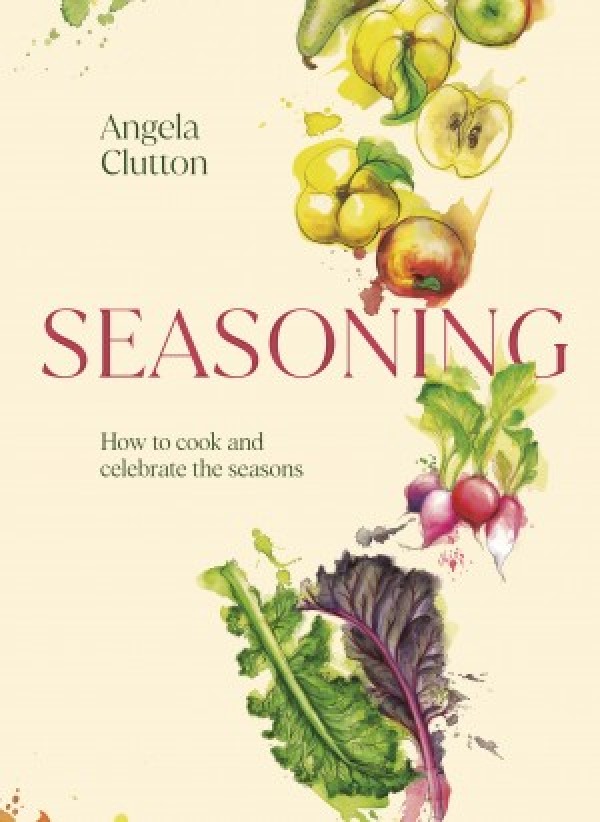
Seasoning
by Angela Clutton
(Murdoch Books, Hardcover RRP £30)
Join Our World... Sign up for our exclusive newsletter.

Be inspired every day with Living North



The delight of this roasted joint is that it starts off with the aubergine rounds making a bed for the meat. There they can take on its fat and juices as the lamb cooks, with the spicy chermoula and sherry vinegar marinade seeping into them too. The lamb then carries on to cook into tenderness, and the aubergines are blitzed to a creamy sauce with garlic and yoghurt.Save any leftover aubergine cream to toss over hot new potatoes, or spread on bread.
Preheat the oven to 220C fan/gas mark 9.
Peel four garlic cloves, crush, put into a mortar with a good pinch of salt and pestle to a paste. Mix with the chermoula, oil and vinegar to make a loose paste.
Trim and peel the aubergines, and then slice into rounds, one centimetre thick. Lay them in a large roasting tin, arranging the aubergines to be roughly the same size as the lamb.
Sit the lamb skin-side up on top of the aubergines. Pierce its skin several times with the point of a sharp knife. Rub the chermoula paste over the skin. Loosely cover the roasting tin with foil, put into the oven and immediately turn the oven down to 170C fan/gas mark 5.
After one-and-a-half hours, take the tin out and gently lift up the lamb to remove the aubergine slices. Some might be stuck to the base of the joint – be sure to get them all. Put the aubergines slices into a sieve set over a bowl to drain.
Pour 200ml of hot water into the roasting tin (but not over the meat), cover it again, return to the oven and turn the temperature down to 140C fan/gas mark 2.
Roast for a further two-and-a-half hours, then put the oven back up to 220C fan/gas mark 9, take off the foil, and return to the oven for a final 20 minutes. Carefully lift out the lamb and set aside to rest.
Make the aubergine cream while the lamb rests: Peel and roughly chop the remaining two garlic cloves. Blitz the aubergine flesh with the garlic, yoghurt and lemon juice. Season, being particularly generous with the salt. Finely chop the mint leaves from one of the mint sprigs and scatter over. Serve with more mint to garnish.

Tart gooseberries spare the over-sweet blushes of a pavlova by bringing a little edge to the flavour party. This is a beauty of a seasonal dessert, with flavours of elderflower, bay and coconut all chiming in. This recipe makes more curd than is needed for the pavlova. That is an intentional and very good thing, most especially for spreading onto toast.
To make the curd, top and tail the gooseberries. Put them into a medium saucepan with the elderflower cordial, 50ml water and the bay leaf.
Gently simmer for about five minutes and watch for when the gooseberries are just starting to collapse. At that point use a slotted spoon to lift out around 50g (2oz) of the gooseberries and set those aside. Carry on cooking the rest for about another 5 minutes until fully collapsed. Discard the bay leaf, set aside to cool, then push everything in the pan through a fine sieve, really rubbing at the fruit with a spoon to get as much through as possible.
Next, beat the eggs (whole and yolks) in a bowl, adding to them the gooseberry purée, butter and caster sugar. Sit the bowl over a pan of gently simmering water, making sure the base of the bowl isn’t touching the water. Stir continuously until it thickens, about 10–12 minutes, then straight away push the curd through a sieve. Pour into a bowl and chill for an hour or so to thicken up.
To make the meringue, preheat the oven to 170C fan/gas mark 5. Line a baking tray with baking paper and draw a circle about 23cm in diameter on the paper.
Put the egg whites into a scrupulously clean mixing bowl, add a pinch of salt and whisk to create stiff peaks. Whisk in about a third of the caster sugar; then add the rest a spoonful at a time, whisking after each addition. Keep whisking until the meringue is thick and glossy. Fold in the vinegar, then spoon the meringue into the circle on the paper, banking it up at the sides a little.
Place in the oven and immediately turn it down to 135C/gas mark 2. Cook for one hour, then turn the oven off and do not be tempted to open the door. Leave the pavlova in the oven to cool. From here it can be kept for up to a day in an air-tight container.
To build the pavlova, toast the coconut chips or flakes in a dry frying pan. Whip the cream with the icing sugar and elderflower cordial/liqueur until thick but not completely stiff. Sit the meringue base on a serving plate. Spoon over enough curd for a base of a few millimetres thick, then spoon over the whipped cream.
Finish by scattering over the reserved poached gooseberries, the coconut, more curd and, if using, the elderflowers or other edible flowers to decorate. Serve soon. Spoon the rest of the curd into sterilised jars and store in the fridge.

by Angela Clutton
(Murdoch Books, Hardcover RRP £30)